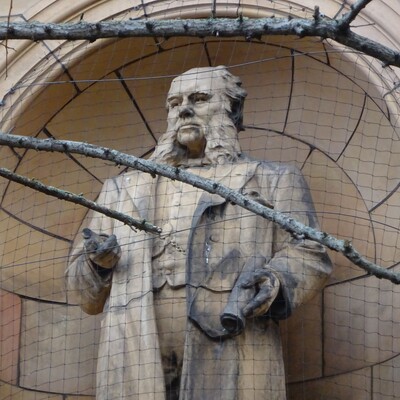IOHANNES HICCOCKS
Magister in Cancellario
Vir
Integer Vitae in Forensi negotio
Inter severiores Iurisprudentiæ Litteras
Urbanitate Morum conspicuus
In rerum Civilium Vicissitudine
Civis Bonus, et Inconcussus
In labefacta Valetudine, et acutis doloribus
Sui potens, et Comes in amicos.
Curiam Suam penitus inspectam
Et exagitatas acerrime fraudum Latebras
Lucro apponebat:
Virtutis enim Intemeratæ suæ Famam stabilivit
Temerata Suspicio.
Obijt V. Apr. MDCCXXVI.
Ætat. LVIII.
{This Latin translates as:}
JOHN HICCOCKS
Master in Chancery
A man who was honest in life and in his dealings with the most serious areas of law in the courts.
He was distinguished in matters of city life and in the affairs of the State.
He was a good citizen and, despite his weakened health and being in severe pain, he was able to remain unshaken and a companion to his friends.
He made a point of thoroughly examining his own senate and eagerly exposing dishonesty and loopholes.
Any hint of misdoing in others confirmed his reputation for pure honesty.
He died on 5th April 1726, aged 58.
Our Latin consultant, David Hopkins, didn’t find it easy to translate descriptions of a person’s character but it reads well to us. He added “I suspect some of the points may refer to specific events I don’t know the details of, e.g. dealing with a particular political scandal or the trial of an establishment figure.”
Historic England dates this sculpture to early 18th century.
The 1803 "Londinium Redivivum Or an Antient History and Modern Description of London", in its catalogue of the interior of the church, refers to this monument which rather confirms our thoughts that it was a tomb ornament, not intended to be open to the elements.
In his 1928 'People's Album of London Statues' (pp 71-2) Osbert Sitwell includes this statue, with a drawing. He provides a small amount of information about Hiccocks and spends the rest of the entry discussing wigs and their history.
2024: Deb Chowney contacted us to say that it's likely the monument was commissioned by Hiccocks' widow, who died in 1737, which would put an upper limit on the date of the monument.
Site: John Hiccocks & Oliver Goldsmith (2 memorials)
EC4, Middle Temple, Falcon Court
The Goldsmith plaque is laid into the ground and can be seen towards the lower right of our photo.









Comments are provided by Facebook, please ensure you are signed in here to see them